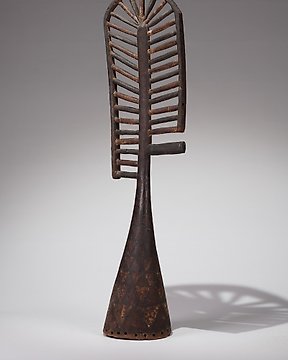
古倫西 - 有吉納法索
編號 82822753

編號 82822753

A Kurumba antelope mask, delicately carved, showing the animals lightness, a long slender neck, thin jaw and strong thick horns, beautiful encrusted shells through out; thick encrusted patina, signs of use. Certificate of provenance.
" The Kurumba people produce a mask headdress in the form of an antelope. The powerful neck supports a head with a long pointed protruding snout. Earlier versions had large ears curving to the towering horns in a semi-circular fashion (echoing the curve of the chi wara mane of the Bamana). These earlier versions were fashioned with masks covering the face much like the masks of neighboring Dogon cultures.
Pre-colonial styles were painted with geometric designs in natural pigments of white (kaolin), black (river mud or charcoal) and reddish brown (ochre) as are the Dogon masks. More recent styles have long sharp ears (many still curving towards the tall horns) and are colorfully painted with more distinct patterns of triangles in white, brownish-red, black, light blue and yellow ochre. As in the earlier models, the triangles are filled with rows of white dots. The horns are banded in stripes of the same colors (Wassing p. 182).
The new styles are secured to the top of the head with head and shoulders disguised with raffia. The dancer wears a raffia skirt. Like the Bamana, they dance in pairs and sometimes appear with a masked hyena dancer as in the photo below from the book "The Dance, Art and Ritual of Africa" by Michel Huet.
Kurumba masks are used in three major events during the annual cycle: masks escort the corpse of dead male and female elders to the tomb and supervise the burial on behalf of the spirits of the ancestors of the clan. Weeks or even months later, during the dry season, masks appear at funerals to honor the deceased and to free the spirit to travel to the world of ancestors. Finally, just before the first rains in late May and June, masks appear at collective sacrifices in which the ancestors are honored together with the spirits of the protective antelope, Hippotragus koba, that is the totem of most Kurumba clans.
These functions conform to patterns throughout Burkina Faso, especially in the north. Masks appear for the same events among the northern Mossi, in Yatenga, Risiam, and Kaya, because the ancestors of the northeastern Mossi who use masks were Kurumba. At funerals, and at public performances following the funeral, masks are physical reembodiments of the spirit of the deceased elder, and the mask may be addressed using the dead person's name. The mask is a means of preserving the memory of the dead, by providing a physical reminder of the dead elder's achievements in life. As among the Mossi, masks are used as portable altars on which the living may offer sacrifices to the dead, securing their blessings for the year to come. In addition, the mask carved at the death of a high-ranking clan elder serves to enhance the prestige of the deceased. When not in use, masks may be placed on altars in the ancestral spirit house within the family compound.
Among the Kurumba as among peoples in central Burkina Faso, the geometric patterns painted on masks are symbols that refer to major events in the myths of the founding of the clan, and the masks themselves represent the antelope that played a role in these stories when it saved the life of the founding elder."
Sources: A History of Art in Africa / Africa - The Art of a Continent / The Tribal Art of Africa / The Dance, Art and Ritual of Africa.